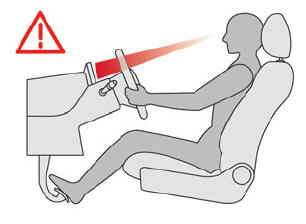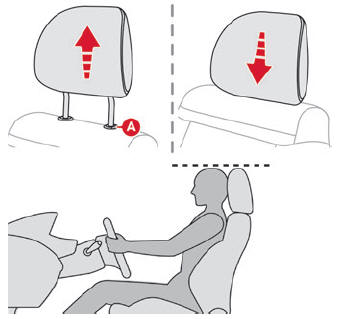Citroen C3: Ease of use and comfort / Correct driving position
Citroen C3 2016-2025 Owners Manual / Ease of use and comfort / Correct driving position
 For safety reasons,
adjustments must
only be made when the vehicle is
stationary.
For safety reasons,
adjustments must
only be made when the vehicle is
stationary.
Before taking to the road and to make the most of the ergonomic layout of the instruments and controls, carry out these adjustments in the following order:
- head restraint height.
- seat backrest angle.
- seat cushion height.
- longitudinal seat position.
- steering wheel height.
- rear view mirror and door mirrors.

 Once these adjustments
have been
made, check that the instrument panel
can be viewed correctly from your driving
position.
Once these adjustments
have been
made, check that the instrument panel
can be viewed correctly from your driving
position.
Height adjustment

- Upward: pull the head restraint up to the desired position; the head restraint can be felt to click into position.
- Downward: press lug A to lower the head restraint.
 The
adjustment is correct when the
upper edge of the head restraint is level
with the top of the head.
The
adjustment is correct when the
upper edge of the head restraint is level
with the top of the head.
Removing a head restraint
- Pull the head restraint fully up.
- Press lug A to release the head restraint and raise it fully.
- Stow the head restraint securely.
Refitting a head restraint
- Insert the head restraint rods into the guides in the corresponding seat backrest.
- Push the head restraint down as far as it will go.
- Press the lug A to release the head restraint and push it down.
- Adjust the height of the head restraint.
 Never drive with the head
restraints
removed; they should be in place and
adjusted for the occupant of the seat.
Never drive with the head
restraints
removed; they should be in place and
adjusted for the occupant of the seat.
 Front seats
Front seats
For safety reasons, seat
adjustments
must only be made when the vehicle is
stationary.
Before moving the seat
backwards,
ensure that there is no person or object
that might prevent the full travel of the seat...
Other information:
Citroen C3 2016-2025 Owners Manual: Active Safety Brake with Collision Risk Alert and Intelligent emergency braking assistance
Refer to the General recommendations on the use of driving and manoeuvring aids. This system: warns the driver that their vehicle is at risk of collision with the vehicle in front or a pedestrian. reduces the vehicle's speed to avoid a collision or limit its severity...
Citroen C3 2016-2025 Owners Manual: Door mirrors
Each fitted with an adjustable mirror glass permitting the lateral rearward vision necessary for overtaking or parking. They can also be folded in for parking in narrow spaces. Demisting/Defrosting If the vehicle is so equipped, demisting/ defrosting of the heated door mirrors is performed when the heated rear screen is switched on...
Categories
- Manuals Home
- 3rd Generation C3 Owners Manual
- 3rd Generation C3 Service Manual
- Speed limiter
- Pairing a Bluetooth® telephone
- Setting the date and time
- New on site
- Most important about car
Copyright © 2025 www.citroenc3.org

